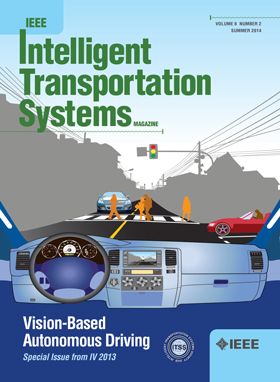基于启发式的多代理深度强化学习方法,用于在非信号灯路口协调互联车辆和自动驾驶车辆
IF 7.9
1区 工程技术
Q1 ENGINEERING, CIVIL
IEEE Transactions on Intelligent Transportation Systems
Pub Date : 2024-10-11
DOI:10.1109/TITS.2024.3407760
引用次数: 0
摘要
车联网和自动驾驶汽车(CAV)的一个典型应用是在混合交通的非信号交叉路口协调多辆CAV,它可以利用多代理深度强化学习(MDRL)方法来提高整体协调效率。本研究在基于值的 MDRL 算法 QMIX 的基础上,提出了一种基于启发式的 MDRL 算法(H-QMIX)。该算法包含一个基于启发式的行动掩码模块,用于引导 CAV 高效、安全地通过交叉路口,该模块由刺激性通过序列和对 CAV 在交叉路口区域行动空间的安全限制组成。与其他 MDRL 算法(如 IPPO、QMIX)相比,H-QMIX 算法在两个案例研究中展示了在安全性和效率方面更高的训练性能,其中第一个案例研究要求所有 CAV 贴上自己的路线,另一个案例研究允许 CAV 随机选择路线。关于模型的泛化能力,训练出的具有最大偶发回报率的模型随后被以零点的方式转移到具有一定车对车(V2V)通信延迟的更实际的场景中。仿真结果表明,H-QMIX 对一定的通信延迟具有鲁棒性。本文代码见:https://github.com/flammingRaven/heuristic_based_qmix。本文章由计算机程序翻译,如有差异,请以英文原文为准。
Heuristic-Based Multi-Agent Deep Reinforcement Learning Approach for Coordinating Connected and Automated Vehicles at Non-Signalized Intersection
One typical application of connected and automated vehicles (CAVs) is to coordinate multiple CAVs at a non-signalized intersection in mixed traffic, and it may take advantage of multi-agent deep reinforcement learning (MDRL) approaches to improve the overall coordination efficiency. This study proposes a heuristic-based MDRL algorithm (H-QMIX) developed based on a value-based MDRL algorithm, QMIX. This algorithm incorporates a heuristic-based action mask module to guide CAVs efficiently and safely through intersections, composed of a stimulative passing sequence and safety restrictions on CAVs’ action space in the junction area. Compared with other MDRL algorithms (e.g., IPPO, QMIX), the H-QMIX algorithm demonstrates improved training performance in terms of safety and efficiency in two case studies, where the first requires all CAVs to affix their routes, and another allows CAVs to choose random routes. Concerning the model’s generalization ability, the trained models with the maximal episodic return are then transferred to a more practical scenario with a certain vehicle-to-vehicle (V2V) communication delay in a zero-shot manner. The simulation results illustrate that H-QMIX is robust to a certain communication delay. The code for this paper is available at:
https://github.com/flammingRaven/heuristic_based_qmix
.
求助全文
通过发布文献求助,成功后即可免费获取论文全文。
去求助
来源期刊

IEEE Transactions on Intelligent Transportation Systems
工程技术-工程:电子与电气
CiteScore
14.80
自引率
12.90%
发文量
1872
审稿时长
7.5 months
期刊介绍:
The theoretical, experimental and operational aspects of electrical and electronics engineering and information technologies as applied to Intelligent Transportation Systems (ITS). Intelligent Transportation Systems are defined as those systems utilizing synergistic technologies and systems engineering concepts to develop and improve transportation systems of all kinds. The scope of this interdisciplinary activity includes the promotion, consolidation and coordination of ITS technical activities among IEEE entities, and providing a focus for cooperative activities, both internally and externally.
 求助内容:
求助内容: 应助结果提醒方式:
应助结果提醒方式:


